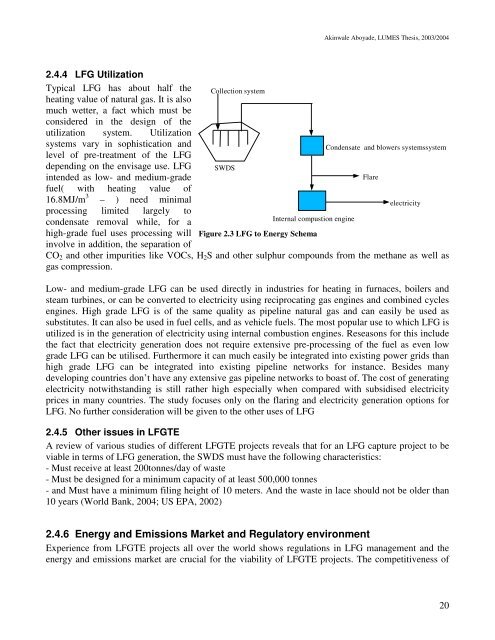Wale Aboyade's thesis - lumes
Wale Aboyade's thesis - lumes
Wale Aboyade's thesis - lumes
Create successful ePaper yourself
Turn your PDF publications into a flip-book with our unique Google optimized e-Paper software.
Akinwale Aboyade, LUMES Thesis, 2003/2004<br />
2.4.4 LFG Utilization<br />
Typical LFG has about half the<br />
heating value of natural gas. It is also<br />
Collection system<br />
much wetter, a fact which must be<br />
considered in the design of the<br />
utilization system. Utilization<br />
systems vary in sophistication and<br />
level of pre-treatment of the LFG<br />
Condensate and blowers systemssystem<br />
depending on the envisage use. LFG SWDS<br />
intended as low- and medium-grade<br />
Flare<br />
fuel( with heating value of<br />
16.8MJ/m 3 – ) need minimal<br />
processing limited largely to<br />
electricity<br />
condensate removal while, for a<br />
high-grade fuel uses processing will<br />
Internal compustion engine<br />
Figure 2.3 LFG to Energy Schema<br />
involve in addition, the separation of<br />
CO 2 and other impurities like VOCs, H 2 S and other sulphur compounds from the methane as well as<br />
gas compression.<br />
Low- and medium-grade LFG can be used directly in industries for heating in furnaces, boilers and<br />
steam turbines, or can be converted to electricity using reciprocating gas engines and combined cycles<br />
engines. High grade LFG is of the same quality as pipeline natural gas and can easily be used as<br />
substitutes. It can also be used in fuel cells, and as vehicle fuels. The most popular use to which LFG is<br />
utilized is in the generation of electricity using internal combustion engines. Reseasons for this include<br />
the fact that electricity generation does not require extensive pre-processing of the fuel as even low<br />
grade LFG can be utilised. Furthermore it can much easily be integrated into existing power grids than<br />
high grade LFG can be integrated into existing pipeline networks for instance. Besides many<br />
developing countries don’t have any extensive gas pipeline networks to boast of. The cost of generating<br />
electricity notwithstanding is still rather high especially when compared with subsidised electricity<br />
prices in many countries. The study focuses only on the flaring and electricity generation options for<br />
LFG. No further consideration will be given to the other uses of LFG<br />
2.4.5 Other issues in LFGTE<br />
A review of various studies of different LFGTE projects reveals that for an LFG capture project to be<br />
viable in terms of LFG generation, the SWDS must have the following characteristics:<br />
- Must receive at least 200tonnes/day of waste<br />
- Must be designed for a minimum capacity of at least 500,000 tonnes<br />
- and Must have a minimum filing height of 10 meters. And the waste in lace should not be older than<br />
10 years (World Bank, 2004; US EPA, 2002)<br />
2.4.6 Energy and Emissions Market and Regulatory environment<br />
Experience from LFGTE projects all over the world shows regulations in LFG management and the<br />
energy and emissions market are crucial for the viability of LFGTE projects. The competitiveness of<br />
20

















